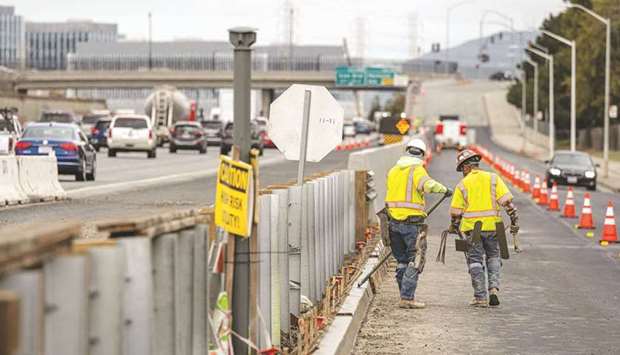President Joe Biden is betting that a multitrillion-dollar economic plan centred around infrastructure spending will do more than bolster an American economy hammered by the coronavirus pandemic: It will ensure his country’s competitiveness against China for decades to come.
“If we don’t get moving, they’re going to eat our lunch,” Biden told lawmakers in a pitch for his proposal shortly after his call last month with Chinese President Xi Jinping. “We just have to step up.”
Biden’s advisers will present him this week with a detailed proposal for a plan whose cost could touch $3tn, according to three people familiar with the deliberations. Infrastructure and climate change have long been described as key efforts in the pending programme, and the new details show the administration is eyeing some $400bn in so-called green spending, according to one of the people.
Even if he gets all he asks for, catching up to China on infrastructure won’t be easy. While US officials have been promising an approaching “infrastructure week” since the early days of the Trump administration, China has been plowing ahead for years. In February, Xi’s government set out a 15-year plan for the country’s transportation network. It pledges to extend China’s rail network from 146,300 kilometres (91,000 miles) in 2020 to about 200,000 kilometres by 2035 - enough to circle the equator more than five times.
The plan also calls for adding 162 new civilian airports, after Beijing’s new $11bn international airport opened last year.
In contrast, the US has built just one major airport – Denver international – since the mid-1990s. And on rail, even a bipartisan effort to build the long-sought “Gateway” rail tunnel between New York and New Jersey – part of the busiest rail line in the US – has foundered in recent years.
China’s infrastructure efforts aren’t limited to China. Since Xi introducing the so-called Belt and Road initiative in 2013, the World Bank estimated China has built or pledged to construct $575bn in energy plants, railways, roads, ports and other projects across the globe from Sri Lanka to Greece. Morgan Stanley in 2018 said total spending on the effort could reach $1.3tn by 2027.
Biden is hoping to begin levelling the playing field. If he can win support for his plan in a deeply divided Congress, there’s certainly no shortage of projects to work on. The US got an early start on all its infrastructure, but much of it is now ageing or decrepit. According to the American Society of Civil Engineers 2021 Infrastructure Report Card, 43% of US public roadways are in poor or mediocre condition, and 42% of the nation’s 617,000 bridges are at least 50 years old. About 7.5% of them are considered structurally deficient.
“The US is entering what could be a decades-long competition in which economic and technological power will matter just as much, if not more, than military might,” Jonathan Hillman, a senior fellow at the Center for Strategic and International Studies, wrote last month. “Starting this race with decaying infrastructure is like lining up for a marathon with a broken ankle.”
The engineering report doesn’t go into another challenge that may have a defining imprint on competitiveness between the US and China: technology infrastructure. The US is still mired in domestic political debates about how to get broadband technology rolled out across the nation. More than a third of Americans in rural areas still lack high-speed access, according to the Federal Communications Commission. Money to help close that gap is expected to be part of any new US proposal.
Basic materials stocks are among those likely to benefit from increased spending on infrastructure projects such as roads and bridges, traditional favourites of lawmakers.“Activity in the US cement industry is poised to surge through 2021, with a potential government infrastructure package expected to spur an acceleration” in second-half demand, Bloomberg Industries analyst Sonia Baldeira wrote in a March 16 note.
Cemex SAB’s American depositary receipts surged 29% this year through Monday, about six times the gain in the Standard & Poor’s 500 Index. Construction supplier Eagle Materials Inc leaped 26%, while aggregates producer Martin Marietta Materials Inc jumped 13%.
Rail failures: Despite Biden’s impulse to push for big spending, the track record of recent presidents suggest he’s likely to fall short.
Donald Trump, a real estate developer who was touted as a potential “builder president” upon his arrival in Washington, proposed a $1tn infrastructure plan – funded mostly by private investment – that never won approval.

Contractors work on a road under repair along Highway 101 in San Mateo, California. President Joe Biden is betting that a multi-trillion economic plan centred around infrastructure spending will do more than bolster an American economy hammered by the coronavirus pandemic: It will ensure his country’s competitiveness against China for decades to come.


